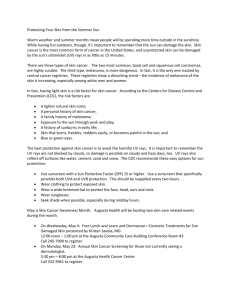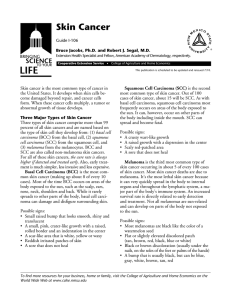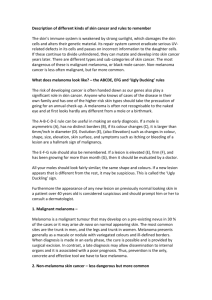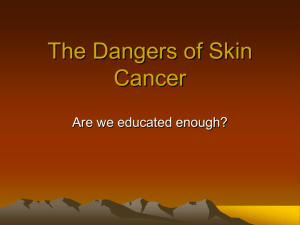Dehydration - imaginesouthvero.org
advertisement
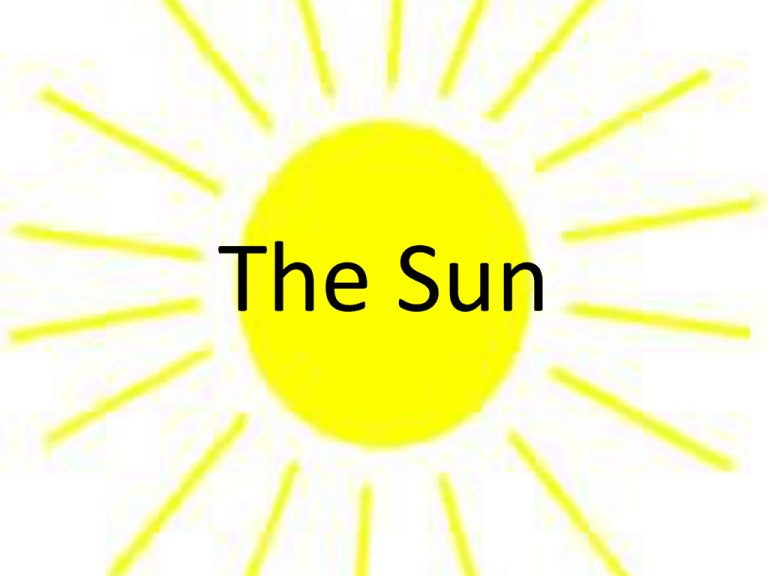
The Sun What are UV rays? UV rays They are invisible rays that are part of the energy that comes from the sun. 3 Types of UV rays • UVA rays cause skin aging and wrinkling and contribute to skin cancer, such as melanoma. Because UVA rays pass effortlessly through the ozone layer (the protective layer of atmosphere, or shield, surrounding the earth), they make up the majority of our sun exposure. • UVB rays are also dangerous, causing sunburns, cataracts (clouding of the eye lens), and effects on the immune system. They also contribute to skin cancer. Melanoma, the most dangerous form of skin cancer, is thought to be associated with severe UVB sunburns that occur before the age of 20. • UVC rays are the most dangerous, but fortunately, these rays are blocked by the ozone layer and don't reach the earth. How is the sun good for us? Benefits of the Sun! • • • • Keeps Earth in place. Keeps us warm. Give us light. Under the action of the sunlight, the skin synthesizes vitamin D, which makes possible calcium absorption in the intestine, helping the organism grow strong bones. • Exposure to the sun strengthens the cardiovascular system. How is the sun bad for us? Dangers of the Sun! • • • • • • Can cause eye damage. Causes cancer Makes you age Can damage your immune system. Will burn your skin. Can cause skin damage. How can we protect ourselves from the sun? Ways to stay safe from the sun! • • • • Wear protective clothing. Wear sunglasses Wear a hat Don’t stay out in the sun for a long period of time. • Apply sunscreen often. What are the different types of skin cancer? Types of Skin Cancer • • • • • Basal Cell Carcinoma Squamous Cell Carcinoma Malignant Melanoma Actinic Keratosis Kaposi's Sarcoma Basal Cell Carcinoma • Cure rate of 95 percent. • Known as non-melanoma skin cancer. This is because it has not spread to any other part of the body. • Appears mostly on the trunk of the body, head, hands and neck. • Appears as small fleshy bumps and rarely spreads to other parts of the body. • If untreated, it can grow below the skin to the bone causing damage. • Can also put people at risk of developing other skin cancers after they have been diagnosed with this. Squamous Cell Carcinoma • Usually found along the facial areas like the ear, lips, face and mouth. • It can spread to other parts of the body. • Is noticeable on the skin. The part of skin with Squamous Cell Carcinoma will become red with scaly patches. • This form of skin cancer is highly treatable but is a bit more aggressive than Basal Cell Carcinoma. Malignant Melanoma • Rarest form of skin cancer and usually only occurs in adults. • A more serious form of skin cancer than basal cell or squamous cell cancer. • Has the highest death rate, responsible for 75 percent skin cancer deaths. • Malignant melanoma appears mostly on fair skinned people who do not tan easily. • Signs are change in color or shape of a mole. Bleeding and oozing from the mole can also occur. The mole may also feel hard, swollen and tender, and can have an itch associated with it. • When malignant melanoma occurs, it has spread to other parts of the body. This makes the skin cancer harder to treat and aggressive measures are often used. • Removal of the skin cancer is the first priority, and depending on how much the cancer has spread, a round of chemotherapy can be given Kaposi's Sarcoma • Begins in the blood vessels. • Slow growing form or an aggressive growing form of skin cancer. • The slower form of Kaposi's Sarcoma often occurs on the leg. • Usually starts out as a raised or flat purple area. sometimes this area can also have a color of dark brown. • Can show up on any part of the body. • In the aggressive form, it ranges in color from pink to purple or red. • The shape appears round or oval. • It can also grow inside the body during this aggressive form. Actinic Keratosis • Appears as a scaly or crusty bump on the area of the skin. • Skin may be dark, light red, tan or pink. There may also be a mixture of these colors combined. • Signs of Actinic Keratosis is itching of the skin or tenderness. • Many people notice this skin condition by touching it rather than seeing it. • Most often found on bald scalps, hands, forearms, lips, neck, back, ears and face. Why would you want to go out in the sun without protecting your skin? What are other illnesses we can get from being hot? Heat related illnesses • Heat rash – Occurs when the sweat ducts to the skin become blocked or swell, causing discomfort and itching • Heat edema – Swelling in the legs and hands, which can occur when sitting or standing for a long time in a hot environment • Heat syncope – Fainting due to low blood pressure when heat causes the blood vessels to expand and body fluids gravitate to the legs • Heat cramps - are the mildest form of heat injury and consist of painful muscle cramps and spasms that occur during or after intense exercise and sweating in high heat. • Heat exhaustion - is more severe than heat cramps and results from a loss of water and salt in the body. It occurs in conditions of extreme heat and excessive sweating without adequate fluid and salt replacement. Heat exhaustion occurs when the body is unable to cool itself properly and, if left untreated, can progress to heat stroke. • Heat stroke - the most severe form of heat illness, occurs when the body's heat-regulating system is overwhelmed by excessive heat. It is a lifethreatening emergency and requires immediate medical attention. What is dehydration? Dehydration It means that your body doesn't have enough water in it to keep it working right. Signs of being Dehydrated • • • • • • • • • Excessive thirst Feeling lightheaded, dizzy, or tired Rapid heartbeat Dry lips and mouth Infrequent or dark urine Muscle weakness Headache Tiredness Inability to produce tears 3 Types of Dehydration • Mild dehydration - where you have increased thirst, dry mouth, restlessness along with a normal urine output. • Moderate dehydration – where your thirst is increased but you become drowsy or irritable and can have a reduced urine output. You may have a higher pulse rate and need to take deeper breaths. • Severe dehydration - is the extreme situation where the patient suffers a dry mouth, cold hands and feet, cramps, lethargy and extremely reduced urine output. The skin also loses some elasticity due to loss of water and breathing becomes deeper. Why do you get dehydrated? • Playing hard and having fun. • Not drinking a plenty of fluids. • Having a stomach virus (throwing up) or diarrhea. • Sore throat can cause you to not want to eat or drink anything. • If you have a fever, you can lose fluids because water evaporates from your skin in an attempt to cool your body down. What does it mean to be hydrated? Hydrate Supply water or liquid to maintain a healthy balance. What does that mean to you? Ways to stay hydrated • Have something to drink when you first wake up. • Carry a water bottle with you throughout the day. • Remember to drink BEFORE you get thirsty! • Try to limit caffeinated and sugary beverages. • Eat fruits and vegetables, they contain water! • Keep a glass of water by your bed. Lets Review!
